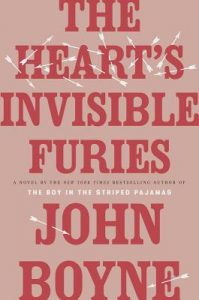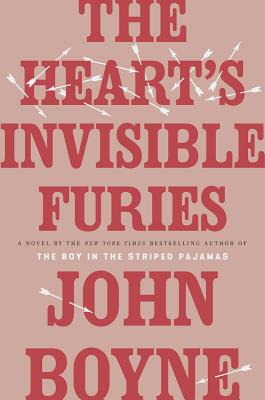 The Heart’s Invisible Furies
The Heart’s Invisible Furies
by John Boyne
Hogarth. 580 pages, $28.
JOHN BOYNE has published nine novels in Ireland and a number of books for young adults, including the international bestseller, The Boy in the Striped Pajamas. He is not, however, known for featuring gay characters or themes, which is perhaps why the jacket copy of The Heart’s Invisible Furies is so coy about its subject matter, namely, the life of a gay man in Ireland from the 1950s to the present. Indeed, looking at the book, one would never know it involved gay themes, which is unfortunate, because it means that some of Boyne’s intended readership may miss this novel.
The target in Boyne’s crosshairs is Irish attitudes toward homosexuality and the historically harsh repression by the Catholic Church. The narrator’s mother is almost literally thrown out of the Church in the opening scene for being an unwed mother. This unfortunate plight leads her to Dublin, where she eventually takes up residence with a welcoming gay man and his partner. Of course, she doesn’t know the two are gay at first (this is 1950s Ireland), but when the two are viciously assaulted by one of the men’s fathers, there can be no further doubt. And it is at precisely this moment that the narrator, Cyril, comes into the world.
That Cyril is literally born in the midst of a gay-bashing episode gives a good sense of the overall flavor—and also the excesses—of this book. Boyne is obviously a devotee of John Irving. The World According to Garp is mentioned, in Dutch, as a time reference in the novel, which itself is dedicated to Irving. Calling The Heart’s Invisible Furies a “gay Garp” would be going too far, but the comparison is apt in many ways.
After Cyril is born, he’s adopted by a very well-to-do family, the Averys, and thus begins his journey through life. Cyril’s adoptive parents are humorous in the way that only the most stereotypically English characters can be. His mother, the allegedly famous novelist Maude Avery, is hilariously self-involved. When he asks her for information about his birth, she replies:
“For heaven’s sake, Cyril … that was seven years ago. How on earth would I recall? Your mother was a girl, I know that much.”
“Don’t you even remember her name?”
“It was probably Mary. Aren’t most Irish country girls named Mary?”
Likewise the “great first love” of Cyril’s life, Julian, is outrageously funny in the early scenes, though his sexual awareness and confidence at age seven strain credulity. At one point he explains why priests assault little boys: “It’s because they’re all so sexually frustrated, of course. They can’t have sex, you see, so they beat up little boys and it gives them stiffies when they do it. It’s the closest they get to orgasms during the day.” Julian and the Averys are so much fun that when they disappear in the second third of the novel, one misses them.
The novel does, in fact, turn more serious in its later sections. In a way, it has to: what narrative of gay men’s lives in the second half of the 20th century could do otherwise? At times, in fact, the novel is reminiscent of the movie Forrest Gump, with the narrator seemingly present at all the most important gay events of the past six or seven decades. Eventually, Cyril makes a decision to hide his true nature and marry a woman, a decision that may divide readers. Indeed, some may feel that the novel and its main character are never truly redeemed.
At one point the narrator is confronted by Julian, who asks: “What the fuck is wrong with you [gay]people? … Why do you always have to lie about everything, hide everything? Why not just tell the truth?” The reality, of course, is that in Ireland and elsewhere it was impossible for a gay person be honest with anyone about what he or she was feeling. Whether Cyril’s big decision is ultimately defensible or not depends a great deal on how one responds to this accusation, which could depend upon the age of the reader and whether he or she lived through those repressive times, which the current generation of gay people has largely forgotten.
Cyril’s decision ultimately causes a break with Julian. It’s is hard to say precisely why his rift with the great love object of his life is so affecting, but it is. Julian and Cyril are nothing alike: Cyril is bookish and shy, and head-over-heels in love with Julian, while Julian is a good-looking, self-centered womanizer whose relationship with Cyril is based mostly good-natured ribbing. But the affection does seem to be heartfelt at root, which is why their split seems so devastating.
It would be a mistake to call this a story of unrequited love, and yet the specter of Cyril’s love for Julian hangs over the entire novel. More accurately, it is the story of one gay man as he makes his way through the events of a lifetime, and eventually makes his own kind of peace with the world. The other mistake one might make would be to assume, perhaps by virtue of its title, that this book is overly serious or heavy. On the contrary: the first third of this novel contains some of the funniest material I’ve ever read. The Heart’s Invisible Furies is a big, messy novel that is cartoonish in places, overly reliant on coincidence, and heavily sentimental. But the sentiments it evokes are very real; expect to shed a few tears at the end.
Dale Boyer’s most recent collection is titled Thornton Stories.






